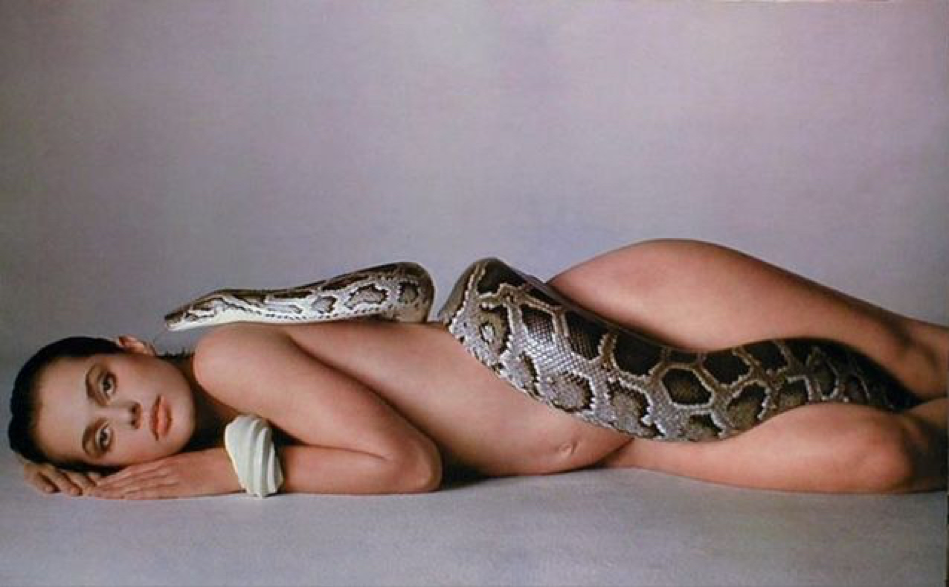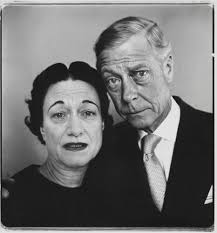Richard Avedon, Nastassja Kinski and the Serpent (1981)

Fig. 1 Richard Avedon, Nastassja Kinski and the Serpent (1981)
A woman lies on her side alongside a plain floor against a plain background of the same neutral colour and material, gazing into the camera lens. She is naked except for a bracelet and the massive coils of a Burmese python wrapped around her legs, waist, and shoulders. She appears calm, even serene. Both she and the animal are long and sinuous—her own snake-like form is accentuated as the photograph has been cropped at her knees, which produces the illusion that her body might somehow run on. She is pale and evenly and softly lit by a source that must be positioned outside the upper left-hand corner of the frame since her face, arm, waist, and knee cast slight shadows to the right. The subtle tonal environment in terms of light and shade leads to a study of textures, materials, lights, and subtle distinctions between skin and scale, body, and background. The scene is undisturbed by action or events.
Or this is almost the case. A very careful look reveals that, in the midst of this scene of stillness, the forked tongue of the snake flickers out to ‘kiss’ the ear of the model—the tiniest sign of vital aliveness in an otherwise perfectly calm image.
Nastassja Kinski and the Serpent, shot in 1981, is one of Avedon’s most famous and iconic photographs and, while similar in terms of the set-up, it also departs from his usual style of the period, where he photographed both famous and unknown figures against a stark white backdrop with no contextual information. Comparing it with Avedon’s portrait of the Duke and Duchess of Windsor, one of his other most famous images, we see ‘a duality: they are photographs taken by a strong, complex personality, a photographer who possesses great humanity—and cold-bloodedness’ (Crenzien, 2014). In Nastassja Kinski and the Serpent we see a return to the softer, more sensual fashion images typical of his earlier work.

Fig. 2 Richard Avedon, Duke and
Avedon’s images usually emerged out of lengthy studio sessions and in his own words ‘A photographic portrait is a picture of someone who knows he (sic) is being photographed, and what he does with this knowledge is as much a part of the photograph as what he’s wearing or how he looks’ (cited in Williams, 2004). This approach distinguished Avedon’s work from that of American street photographers, such as Diane Arbus. Nevertheless, his method enabled him to produce images that remain with the viewer—they have punctum.
Appearing to cast Nastassja Kinski as Eve, the portrait emerges out of the juxtaposition of her human form and the reptilian form of the snake. The imminent threat that the snake seems to present is in intense contrast with the vulnerable body of the female subject and serenity of her expression—but the result is psychological intensity and interest, something that keeps the image alive and makes it interesting to look at closely. This juxtaposition also produces confrontation between a public image and what Avedon sees (or perceives) in the subject. Kinski was a familiar figure as she was one of the most beautiful women of the time and, whilst being exploited in her earlier roles, was beginning to gain control of her career and image. Avedon succeeded in placing her in a situation that produces unexpected sensations.
With this juxtaposition, Avedon’s photograph raises fundamental questions about the power of photography itself. Speaking of his early experience with photography, Avedon recalled how ‘all the photographs in our family album were built on some kind of lie about who we were and revealed a truth about who we wanted to be’ (cited in Mooallem, 2017). Throughout his career, Avedon negotiated this balance between truth and fantasy very skilfully. It is this quality that makes Nastassja Kinski and the Serpent such a compelling picture since it manages to tread a fine line between fact and fiction. While its lighting and tonalities all describe a real relationship between body and space, the event we witness has the mark of the unreal. While, superficially, the portrait appears to cast Kinski as Eve falling for the temptation of the serpent, Avedon captured that precise moment where it is clear that this Eve is not interested in what the serpent has to offer, and nor is she frightened by the power the serpent wields over her. When viewed in 2018 in conjunction with recent interviews, it seems that Avedon perhaps saw and captured what Nastassja Kinski was sub-consciously trying to achieve in her career and image—to live and behave on her own terms.
In conclusion, Avedon’s Nastassja Kinski and the Serpent, shot as part of a fashion shoot for Vogue, is typical of the way in which Avedon used his immense skill as a photographer to change the traditional idea of a fashion image from one in which the model appears as little more than a ‘clothes horse’ and whose role is to passively exhibit fashion ensembles to one in which the model is treated as a subject in his or her own right. Moreover, it is down to Avedon’s treatment of models that they are now as equally important and just as famous as the designers’ clothes that they wear. Traditionally, posing has been static and the focus is only on exhibiting the clothes. In this image Avedon moves away from this convention in multiple ways: firstly, by presenting the model as nude, clothed only by a reptile and bracelet; secondly, by having the model in a supine position with the image cropped at the knee; and, thirdly, by capturing an unpredictable chance encounter and, perhaps most importantly in this case, as revealed by Vogue editor Polly Mellen (YouTube, 2015), Avedon listened to the model and worked with her to create a stunning portrait.
Bibliography
Barthes, R. (1988). Camera lucida. New York: The Noonday Press.
Bate, D. (2009). Photography: The key concepts. 2nd ed. London: Bloomsbury.
Crenzien, H. (2007). Richard Avedon. Humlebæk: Louisiana Museum of Modern Art.
Forbes, T. (2017). The brilliant photos of Richard Avedon. [online] YouTube. Available at: https://www.youtube.com/watch?v=nNWe_vHAQ5s [Accessed 28 Oct. 2018].
Jeffrey, I. (2000). The photography book. London: Phaidon.
Jeffrey, I. (2010). Photography. London: Thames and Hudson.
Jenkins, D. (2015). Nastassja Kinski interview: ‘I’ve had such low self-esteem’. [online] The Telegraph. Available at: https://www.telegraph.co.uk/culture/film/11394696/Nastassja-Kinski-interview-Ive-had-such-low-self-esteem.html [Accessed 9 Nov. 2018].
Mooallem, S. (2017). Avedon’s America. [online] Villagevoice.com. Available at: https://www.villagevoice.com/2017/08/08/avedons-america/ [Accessed 9 Nov. 2018].
Wells, L. (2015). Photography: A critical introduction. London: Routledge, Taylor & Francis Group.
Williams, V. (2004). Richard Avedon. [online] The Independent. Available at: https://www.independent.co.uk/news/obituaries/richard-avedon-550783.html [Accessed 10 Nov. 2018].
YouTube. (2015). Polly Mellen talks about the original Kinski Avedon shoot. [online] Available at: https://www.youtube.com/watch?v=-koFesJp0Bw [Accessed 10 Nov. 2018].
